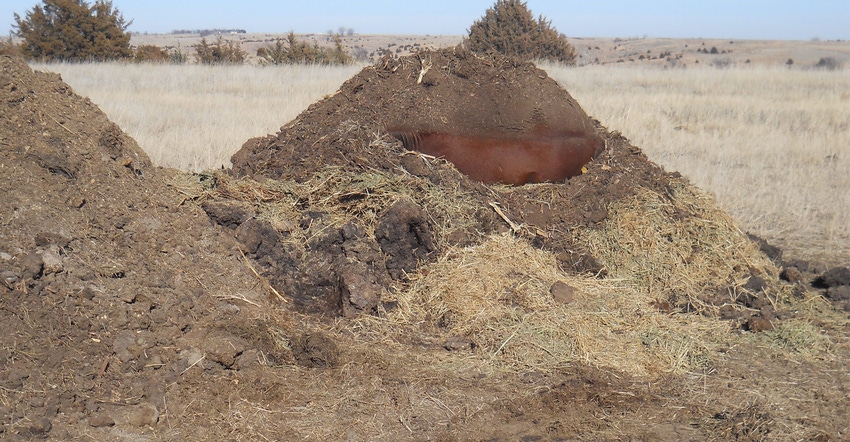
Composting animal mortalities is nothing new. However, thanks to a recent change in Nebraska Department of Agriculture regulations allowing for composting of animals larger than 300 pounds, it is now more acceptable than ever for animal mortalities of any size.
"Rendering dead animals is still the best option, but these days rendering is often not available within 24 to 48 hours of death," Larry Howard, Nebraska Extension educator, told producers at a Beef Profit Tips workshop recently. "Producers also have concerns about biosecurity with rendering trucks coming onto the farm. Frozen ground or a shallow water table often prevents burial from being an option." With recent Nebraska regulatory changes, composting mortalities is a more viable option for cow-calf producers, although it is not widely used by feedlots.
For smaller animals, like calves and pigs, a bin composting system works best, Howard said. A windrow system is easier for larger animals, because it can be extended as needed. For composting to work, carbon, oxygen, moisture and temperature are all that are necessary. Here are the steps:
1. Build a base. Start by piling a base of absorbent high-carbon material like old hay, Howard said. "The base can be from 1 to 2 feet deep, depending on the size of the carcass," he added. "And it should be large enough to allow 1 to 2 feet around the entire animal."
2. Place carcass in the center of the base. Add the carcass to the middle of the base. Be sure to lance the abdomen or rumen to prevent bloating and to speed composition. "This is an important step," Howard said. "Otherwise, bloating can cause the whole compost pile to blow up."
3. Cover the animal. Use 1 to 3 feet of compost material, which could be high-carbon material like manure or previous compost to keep the heat in the pile, Howard said. If you have too little material on top of the carcass, it will slow decomposition and encourage scavengers to raid the pile. Some composters will build a small channel on top of the cover to collect moisture that will soak down into the pile.
4. First heat cycle commences. The temperature in the pile will rise as anaerobic and aerobic activity heat up. High temperatures will break down flesh and small bones. You can use a $60 to $70 temperature probe to monitor and log the temperature trends in the pile. The temperature should rise to above 130 degrees F, and then gradually decline.
5. Monitor pile. Record the date that carcasses are added in the windrow, the number and size of carcasses, and material when it is added, Howard said. Monitor the pile for temperature, moisture, odor, any leachate and any visitations by scavengers.
6. Turn the pile. Once the temperature subsides, you can turn the pile with a skid loader, and add water and carbon if needed to initiate increased aerobic activity.
7. Second heat cycle begins. The temperature will rise again, this time breaking down long bones, skull and pelvis bone into a brittle state. The compost material that results once the temperature again begins to subside should be brown or dark brown with an earthy smell, but no traces of tissue or an offensive odor. It may have some bones left, but they should be brittle and easily broken. If some of the big bones remain, you can choose to turn the pile again or move the large bones to a newly constructed pile with another carcass.

TURNING IT: A skid loader can be used to turn the compost pile after the first heat cycle to encourage a second heat cycle to break down larger bones that may remain. (Photo courtesy of Larry Howard)

The method works best if the animal is still warm when the process is started. For winter composting, Howard suggested starting before the carcass is frozen and using warm or active compost from another pile to surround the carcass and begin the process. Then cap the pile with clean cover material of sawdust, old hay or chopped straw. A minor modification of the Nebraska Department of Environmental Quality permit is required when adding composting practices to a Confined Animal Feeding Operation, but there is no additional fee, Howard explained. You can learn more by contacting Howard at [email protected].
About the Author(s)
You May Also Like






